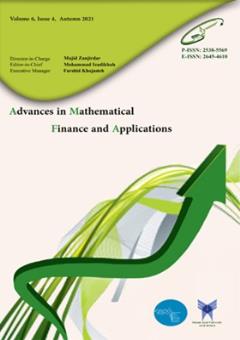Option pricing with artificial neural network in a time dependent market
محورهای موضوعی : Financial Mathematics
Mehran Araghi
1
,
Elham Dastranj
2
,
Abdolmajid Abdolbaghi Ataabadi
3
![]() ,
Hossein Sahebi Fard
4
,
Hossein Sahebi Fard
4
1 - Department of Mathematics, Faculty of Mathematical Sciences, Shahrood University of Technology, Shahrood, Semnan, Iran
2 - Department of Mathematics, Faculty of Mathematical Sciences, Shahrood University of Technology, Shahrood, Semnan,Iran
3 - Department of Management, Industrial Engineering, Amp and Management Sciences, Shahrood University of Technology
4 - Department of Mathematics, Faculty of Mathematical Sciences, Shahrood University of Technology, Shahrood, Semnan, Iran.
کلید واژه: Option pricing, Mikhailov and Nogel model, Artificial neural network, Activation function,
چکیده مقاله :
In this article, the pricing of option contracts is discussed using the Mikhailov and Nogel model and the artificial neural network method. The purpose of this research is to investigate and compare the performance of various types of activator functions available in artificial neural networks for the pricing of option contracts. The Mikhailov and Nogel model is the same model that is dependent on time. In the design of the artificial neural network required for this research, the parameters of the Mikhailov and Nogel model have been used as network inputs, as well as 700 data from the daily price of stock options available in the Tehran Stock Exchange market (in 2021) as the net-work output. The first 600 data are considered for learning and the remaining data for comparison and conclusion. At first, the pricing is done with 4 commonly used activator functions, and then the results of each are com-pared with the real prices of the Tehran Stock Exchange to determine which item provides a more accurate forecast. The results obtained from this re-search show that among the activator functions available in this research, the ReLU activator function performs better than other activator functions.
In this article, the pricing of option contracts is discussed using the Mikhailov and Nogel model and the artificial neural network method. The purpose of this research is to investigate and compare the performance of various types of activator functions available in artificial neural networks for the pricing of option contracts. The Mikhailov and Nogel model is the same model that is dependent on time. In the design of the artificial neural network required for this research, the parameters of the Mikhailov and Nogel model have been used as network inputs, as well as 700 data from the daily price of stock options available in the Tehran Stock Exchange market (in 2021) as the net-work output. The first 600 data are considered for learning and the remaining data for comparison and conclusion. At first, the pricing is done with 4 commonly used activator functions, and then the results of each are com-pared with the real prices of the Tehran Stock Exchange to determine which item provides a more accurate forecast. The results obtained from this re-search show that among the activator functions available in this research, the ReLU activator function performs better than other activator functions.
[1] Björk, T., Arbitrage theory in continuous time, Oxford university press, 2009;
[2] Dastranj, E., Sahebi Fard, H., Abdolbaghi, A., Power option pricing under the unstable conditions (Evidence of power option pricing under fractional Heston model in the Iran gold market), Physica A: Statistical Mechanics and its Applications, 2020; 537:122690.
[3] Dastranj, E., Sahebi Fard, H., Exact solutions and numerical simulation for Bakstein-Howison model, Computational Methods for Differential Equations, 2022; 10(2):461-474.
[4] François-Lavet, V., Henderson, P., Islam, R., Bellemare, M.G., Pineau, J., An introduction to deep rein-forcement learning, Foundations and Trends in Machine Learning, 2018; 11(3-4): 219-354. doi:10.1561/2200000071
[5] Haykin, S., Neural networks and learning machines, Pearson Education India, 2009.
[6] Hull, J., Risk management and financial institutions, 2012; (Vol. 733). John Wiley & Sons.
[7] Kaustubh, Y., Formulation of a rational option pricing model using artificial neural networks, SoutheastCon, IEEE, 2021. doi:10.20944\preprints202012.0426.v1
[8] MacBeth, J.D., Merville, L.J., An empirical examination of the Black-Scholes call option pricing model, The journal of finance, 1979; 34(5), 1173-1186.
[9] Mikhailov, S., Nogel, U., Heston’s stochastic volatility model: Implementation, calibration and some extensions, Wilmott magazine, 2004.
[10] Mitra, S.K., An option pricing model that combines neural network approach and Black-Scholes for-mula, Global Journal of Computer Science and Technology, 2012; 12(4), P. 7-15.
[11] Pagnottoni, P., Neural network models for Bitcoin option pricing, Frontiers in Artificial Intelli-gence, 2019, 2, 5.
[12] Ren, P., Parametric estimation of the Heston model under the indirect observability framework, Diss. University of Houston, 2014.
[13] Sahebi Fard, H., Dastranj, E., Abdolbaghi Ataabadi, A., Analytical and numerical solutions for the pricing of a combination of two financial derivatives in a market under Hull-White model, Advances in Mathematical Finance and Applications, 2022; 7(4), 1013-1023.doi: 10.22034/amfa.2021.1902303.1447
[14] Sharma, S., Sharma, S., Athaiya, A., Activation functions in neural networks, Towards Data Sci, 2017; 6(12): 310-316.
[15] Shuaiqiang, L., Oosterlee, C.W., Bohte, S.M., Pricing options and computing implied volatilities using neural networks, risks, 2019; 7(1):16.
[16] Vasilev, G.S., Time-dependent Heston model, arXiv preprint arXiv, 2014, 1402.5679.
[17] Zohrabi, A., Tehrani, R., Souri, A., & Sadeghi Sharif, S.J., Provide an improved factor pricing model using neural networks and the gray wolf optimization algorithm, Advances in Mathematical Finance and Applications, 2023, 8(1).


